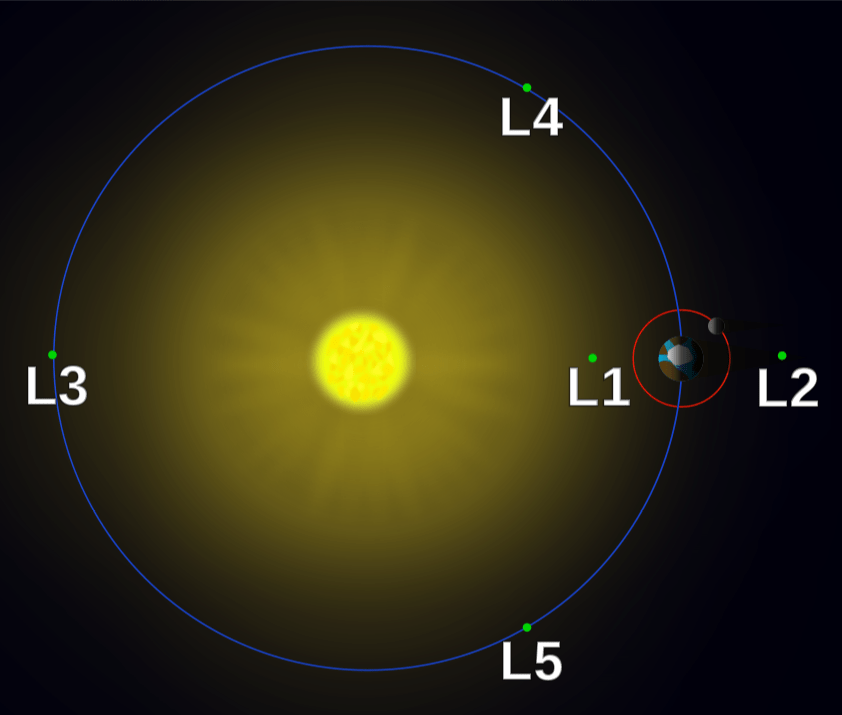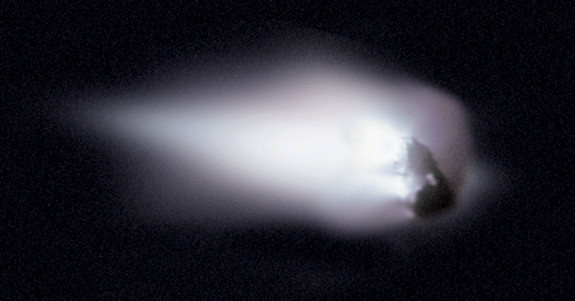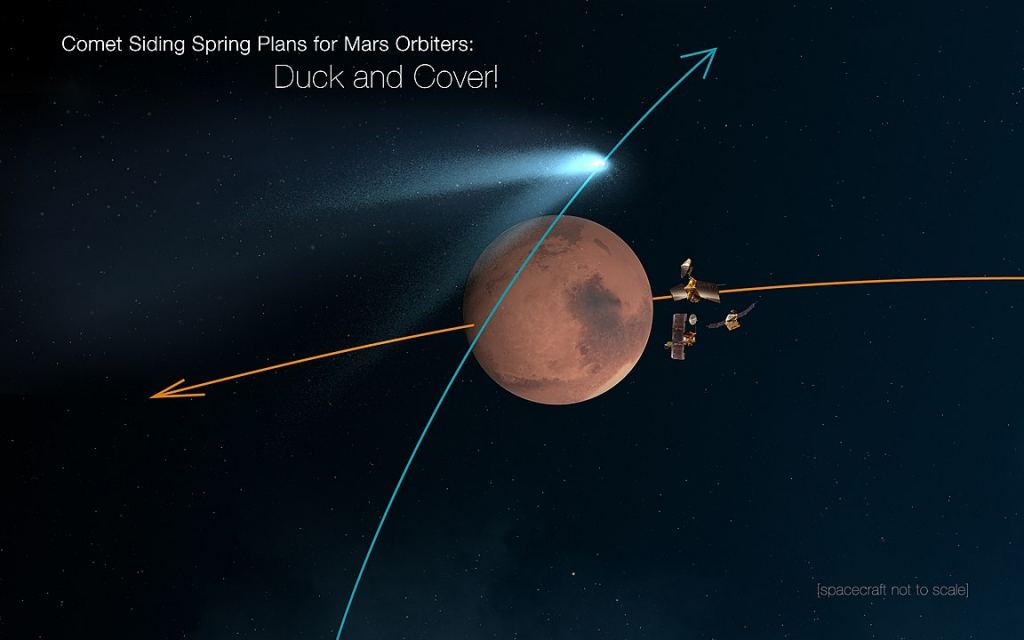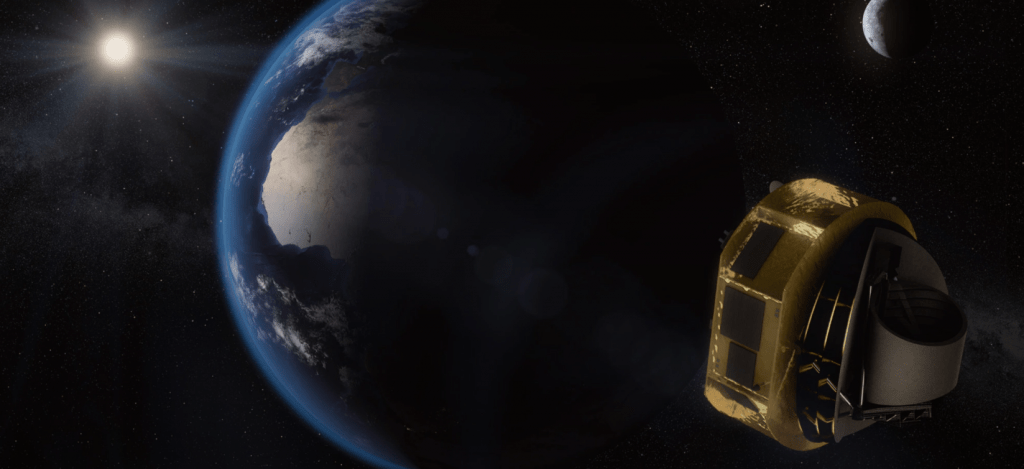The ESA has announced a new mission to explore a comet. The Comet Interceptor mission will have a spacecraft wait in space until a pristine comet approaches the inner Solar System. Then it will make a bee line for it, and do some ground-breaking science.
The Comet Interceptor is unique among space missions. Its exact target is unknown, and it will be designed, built, and launched before its target is identified.
The Interceptor will be a fairly small spacecraft, with a launch mass of less than 1000 kg (2205 lbs.) It’ll be launched as kind of a tag-along-spacecraft on the launch of another medium-sized mission, and it’ll use that boost to make its way to its standby point: LaGrange 2. L2 is about 1.5 million km (1 million miles) from Earth.

Once Comet Interceptor is at L2, it waits for a target. According to the ESA, its target will either be a comet, or some other interstellar object that comes cruising through our system. But not just any comet.
In broad terms, there are two types of comets that come into the inner Solar System and loop around the Sun. Short period comets are bodies that have passed close by our Sun before, multiple times. Their periods are typically less than 200 years, and with each passage close to the Sun, they are changed significantly from their primordial state.
Well-known comets like Halley’s Comet fall into this category, with a period of 76 years. Comet 67P/Churyumov-Gerasimenko, which the ESA’s Rosetta spacecraft visited, has an even shorter period: it visits every 6.5 years.

But these short period comets are not the Comet Interceptor’s target. It’s hunting for a comet that is visiting the Sun for the very first time. The comet, once it’s chosen, will be one that is relatively unchanged since the day it and the rest of the Solar System was formed, about 4.5 billion years ago.
“Pristine or dynamically new comets are entirely uncharted and make compelling targets for close-range spacecraft exploration to better understand the diversity and evolution of comets,” said Günther Hasinger, ESA’s Director of Science. “The huge scientific achievements of Giotto and Rosetta – our legacy missions to comets – are unrivalled, but now it is time to build upon their successes and visit a pristine comet, or be ready for the next ‘Oumuamua-like interstellar object.”
The comet that the Interceptor eventually visits will likely come from the Oort Cloud. The Oort Cloud is the most distant region in our Solar System, and it’s like a gigantic spherical cloud of objects that surrounds our whole System. The Oort Cloud is largely theoretical at this point, since nobody’s ever observed it directly. But it’s thought to be the source of long period comets like Comet C/2013 A1 Siding Spring, which visited the inner Solar System in 2014, and won’t return for another mind-boggling 740,000 years.

Once ESA scientists have identified and chosen a long-period comet, Space Interceptor will fire up its propulsion system and head for a rendezvous. The Interceptor is actually three spacecraft in one, and each of the three will be loaded with complementary science instruments. As the spacecraft approaches the comet, it’ll separate into its three parts.
Each of the three will provide different perspectives of the comet’s nucleus and its gas, dust, and plasma environment. By measuring the comet from three points, scientists will get the kind of detailed 3D information they need to understand the dynamic nature of a pristine comet while it’s being subjected to the constantly changing solar wind environment.
But the Comet Interceptor’s target may not end up being a comet at all. The spacecraft may be directed toward another interstellar object, similar to Oumuamua. Oumuamua visited our Solar System in 2017, and it’s the only interstellar object we’ve detected coming through our system. There was a lot of fun speculation, (and some pretty wild speculation,) on the nature of the object, but in any case, we’ll never see it again. However, scientists say that interstellar objects aren’t exactly rare, and there’s probably one travelling through our Solar System at any given time.

Whether the Comet Interceptor is sent to study a comet or some other object, it’ll be a first for science. In fact, the whole capability to do this mission is rather new.
We now have instruments that can scan the sky more deeply and effectively than ever before. These instruments, like Pan-STARRS and the soon-to-be-built Large Synoptic Survey Telescope, scan the sky automatically, and can give us advance notice of approaching objects. This gives scientists the advantage of being very selective with their target, and to choose carefully and patiently.
The Comet Interceptor is an ‘F-Class’ or Fast Class mission. This title refers to how long it took to choose the project from among the 23 pitches it received from companies since it was announced last July. It also refers to how quickly the craft can be developed. Only eight years will pass between mission selection and launch. That’s pretty quick for a complex space mission.

The Comet Interceptor will be launched in 2028, probably in the same rocket as the ESA’s planet-hunting ARIEL (Atmospheric Remote-sensing Infrared Exoplanet Large-survey) spacecraft, which is also bound for LaGrange Point 2. It’ll take about one month for it to arrive at L2. After that, the waiting begins, and nobody can say how long it’ll be before a desirable target approaches.
But once a target is chosen, and the Comet Interceptor arrives at the comet or other interstellar object, the resulting science will be worth the wait.


Are there LaGrange-like points above or below the ecliptic? Are thinking in 2D here. Maybe Jeff Bezos will fund one above and Elon Musk one below. I would like a number of interceptors deployed spherically.